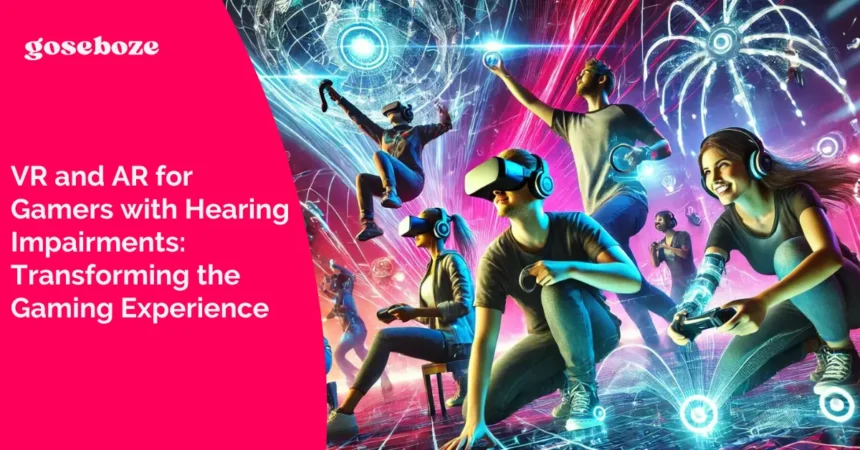The worlds of Virtual Reality (VR) and Augmented Reality (AR) have revolutionized the way we play games. But what happens when the gaming experience is limited by factors beyond control, such as hearing impairments?
Gaming should be inclusive for everyone, and with the rapid advances in technology, VR and AR have begun to level the playing field for gamers who face challenges in hearing. This is where the magic lies—not just in creating immersive universes, but in making sure no one is left out.
Whether you’re a casual gamer exploring legal online casinos or an enthusiast diving into intense multiplayer sessions, technology is transforming how people with hearing impairments can engage with these virtual worlds.
The Rise of VR and AR: A New Era for Accessibility
What is VR and AR?
To understand how VR and AR are breaking accessibility barriers, it’s important to first grasp what these technologies entail. VR offers a completely immersive experience, where the user is transported into a fully digital world, often using headsets and motion-tracking devices. AR, on the other hand, blends the digital with the real, overlaying graphics and information onto the physical environment via smartphones or specialized glasses.
These technologies are now being used in a wide range of applications beyond gaming, from education to healthcare, but gaming remains one of their most impactful uses. For gamers with hearing impairments, VR and AR are making strides to ensure they don’t just participate but thrive.
Challenges Faced by Gamers with Hearing Impairments
Lack of Audio Cues and Communication Barriers
Hearing-impaired gamers face significant obstacles, particularly in multiplayer or interactive gaming environments. Audio cues play a crucial role in many games—whether it’s the sound of an approaching enemy, the crackle of a radio transmission, or team communication in competitive games. These cues often provide critical information that can affect how the game is played and enjoyed.
The lack of subtitles or visual indicators to replace these auditory signals can result in missed opportunities or even frustration for hearing-impaired gamers. In competitive multiplayer settings, where communication is key, the inability to hear voice chats can lead to a feeling of isolation or being at a disadvantage. However, the integration of VR and AR is helping address these issues, making games more accessible and inclusive.
Read Also: Top Ranking Website: 100% Proven Method For Traffic Increase
VR and AR Solutions for Enhanced Accessibility
Visual Cues in Gaming Environments
VR and AR technology has introduced visual replacements for audio cues, such as flashing lights, color changes, or even tactile feedback to signify important in-game events.
In an action-packed VR game, for example, the absence of sound is compensated by visual vibrations or indicators that pop up in the player’s field of vision. This ensures that hearing-impaired gamers still receive critical information and can react just as quickly as their hearing peers.
Speech-to-Text Features for In-Game Communication
A significant breakthrough is the integration of speech-to-text technology. In many multiplayer VR environments, communication is key, and the absence of audio can be detrimental. By enabling real-time transcription, speech-to-text tools help convert voice chats into readable captions for hearing-impaired players.
This not only levels the playing field but also enhances the overall user experience. AR apps like this can even be adapted to help players navigate complex legal online casino environments, ensuring they’re not missing out on essential game strategies or information.
Haptic Feedback as an Alternative
Haptic feedback, or the use of vibrations and other touch sensations, is another exciting area where VR and AR are improving accessibility. For instance, when an in-game event happens—whether it’s an explosion, a character speaking, or an action cue—the VR or AR device can vibrate or pulse in specific ways to alert the player. This form of feedback helps replace auditory signals, offering a more inclusive experience.
The Future of VR and AR Accessibility for Gamers with Hearing Impairments
The advancements we are seeing today in VR and AR are just the tip of the iceberg. As developers become more aware of the need for accessibility, innovations are likely to arise that will continue to enhance the gaming experience for everyone. In the future, we may even see AI integration that learns how each player prefers to receive information and adapts the gaming environment accordingly.
While the current solutions like visual cues, speech-to-text, and haptic feedback are already making a difference, the potential for creating more personalized and inclusive gaming experiences is vast. Gamers with hearing impairments are not just passive participants; they are an active part of the future of gaming.
Game On: The Future is Bright for Inclusive Gaming
As VR and AR technology continue to evolve, the gaming landscape for hearing-impaired players is becoming more inclusive and immersive than ever. With visual cues, speech-to-text technology, and haptic feedback, these innovations are transforming how we engage with digital worlds.
The days of being sidelined due to hearing impairments are fading, and the future is full of exciting possibilities for all gamers, no matter their abilities.








